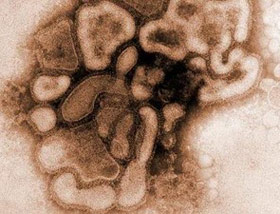Detecting the origin of influenza A (H1N1) virus
 Scientists in Japan and America have discovered the evolutionary origin of the deadly virus A (H1N1) virus.
Scientists in Japan and America have discovered the evolutionary origin of the deadly virus A (H1N1) virus.
This finding will help health agencies find effective measures to prevent and treat this disease.
The separate research results of Japanese and American research groups show that the new influenza virus is a complex virus, formed on the basis of four different viruses including avian influenza virus, human influenza virus and 2 types of virus. swine flu virus.
The group of Japanese scientists, including Kuniaki Nerome, director of the Institute of Biological Resources (IBR) in Okinao province, discovered that among six molecules of RNA (ribonucleic acid) inherited from North American swine flu virus, there is 1 RNA created from human influenza virus, 2 from avian influenza virus and 3 from North American swine flu virus.
Meanwhile, a group of American scientists, including Columbia University researchers, compared genetic information between the new flu virus and the swine flu virus found in previous research.
Comparison results show that of the eight new viral RNA molecules, six are inherited from viruses that have previously caused swine flu in North America and two other RNAs inherited from the swine flu virus strain. Eurasian-type (Eurasian-type) originated in Europe and Asia.
Viruses that cause swine flu and avian flu often do not infect humans. However, pigs can be infected with human flu and bird flu. When this happens, different viruses can be combined to create different types of virus variants.
According to US scientists, the possibility of protein on the surface of the new virus has changed and allowed the virus to spread easily between people.
Scientists hope the new discovery will support efforts to map out effective measures to prevent the spread of influenza A (H1N1) virus from human to human and treat patients with the flu. this new lethal.
Meanwhile, British scientists have begun studying the preparation of a vaccine against influenza A (H1N1) virus. Efforts are underway at the National Institute of Biological Standards (NIBSC), which will prepare a "seed" vaccine from which producers can mass-produce.
According to scientists, the first "seed" strain of this H1N1 (H1N1) vaccine will be built within 3 to 4 weeks. It will take another 4 or 5 months for manufacturers to produce mass vaccines.
- Influenza A / H1N1 outbreak in many parts of the world
- How dangerous is swine flu?
- Influenza A / H1N1 virus does not
- Vaccination against H1N1 can cause neurological disorders
- Virus A / H1N1 is increasingly dangerous
- The new flu pandemic proves a controversial study
- Influenza A / H1N1 virus
- Vietnam successfully studied influenza A / H5N1 vaccine and influenza A / H1N1
- HCM City's first patient infected with H1N1 flu
- The second patient in the South died of H1N1 flu
- Detecting variants of Tamiflu-resistant influenza A / H1N1 virus
- Discovering new compounds better than influenza A / H1N1 virus than Tamiflu
 Green tea cleans teeth better than mouthwash?
Green tea cleans teeth better than mouthwash? Death kiss: This is why you should not let anyone kiss your baby's lips
Death kiss: This is why you should not let anyone kiss your baby's lips What is salmonellosis?
What is salmonellosis? Caution should be exercised when using aloe vera through eating and drinking
Caution should be exercised when using aloe vera through eating and drinking